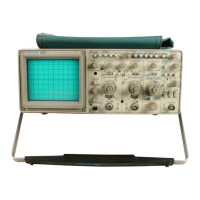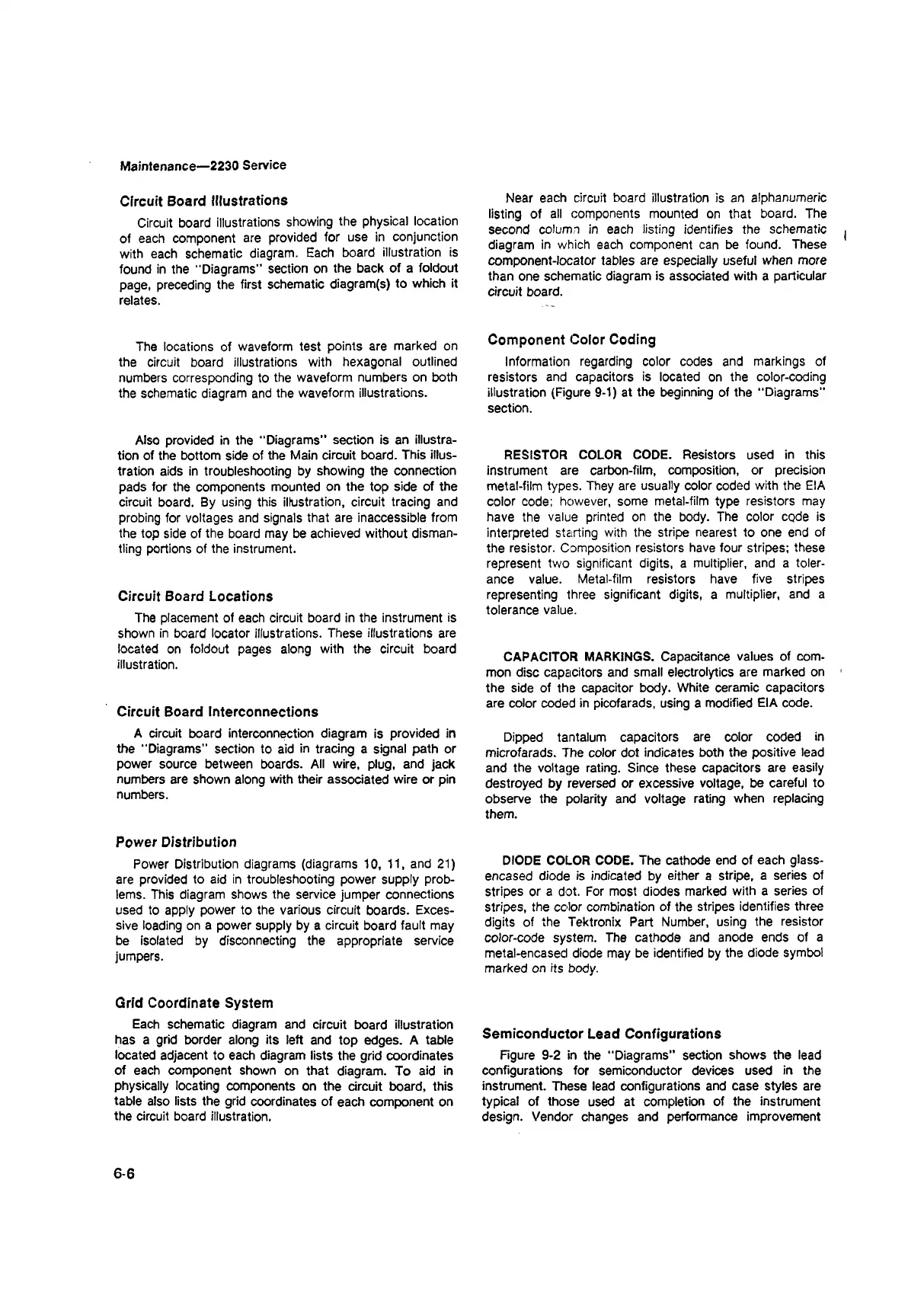Maintenance—2230 Service
Circuit Board Illustrations
Circuit board illustrations showing the physical location
of each component are provided for use in conjunction
with each schematic diagram. Each board illustration is
found in the ‘'Diagrams” section on the back of a foldout
page, preceding the first schematic diagram(s) to which it
relates.
The locations of waveform test points are marked on
the circuit board illustrations with hexagonal outlined
numbers corresponding to the waveform numbers on both
the schematic diagram and the waveform illustrations.
Also provided in the “ Diagrams” section is an illustra
tion of the bottom side of the Main circuit board. This illus
tration aids in troubleshooting by showing the connection
pads for the components mounted on the top side of the
circuit board. By using this illustration, circuit tracing and
probing for voltages and signals that are inaccessible from
the top side of the board may be achieved without disman
tling portions of the instrument.
Circuit Board Locations
The placement of each circuit board in the instrument is
shown in board locator illustrations. These illustrations are
located on foldout pages along with the circuit board
illustration.
Circuit Board Interconnections
A circuit board interconnection diagram is provided in
the "Diagrams” section to aid in tracing a signal path or
power source between boards. All wire, plug, and jack
numbers are shown along with their associated wire or pin
numbers.
Power Distribution
Power Distribution diagrams (diagrams 10, 11, and 21)
are provided to aid in troubleshooting power supply prob
lems. This diagram shows the service jumper connections
used to apply power to the various circuit boards. Exces
sive loading on a power supply by a circuit board fault may
be isolated by disconnecting the appropriate service
jumpers.
Grid Coordinate System
Each schematic diagram and circuit board illustration
has a grid border along its left and top edges. A table
located adjacent to each diagram lists the grid coordinates
of each component shown on that diagram. To aid in
physically locating components on the circuit board, this
table also lists the grid coordinates of each component on
the circuit board illustration.
Near each circuit board illustration is an alphanumeric
listing of all components mounted on that board. The
second column in each listing identifies the schematic j
diagram in which each component can be found. These
component-locator tables are especially useful when more
than one schematic diagram is associated with a particular
circuit board.
Component Color Coding
Information regarding color codes and markings of
resistors and capacitors is located on the color-coding
illustration (Figure 9-1) at the beginning of the “ Diagrams"
section.
RESISTOR COLOR CODE. Resistors used in this
instrument are carbon-film, composition, or precision
metal-film types. They are usually color coded with the EIA
color code; however, some metal-film type resistors may
have the value printed on the body. The color code is
interpreted stairting with the stripe nearest to one end of
the resistor. Composition resistors have four stripes; these
represent two significant digits, a multiplier, and a toler
ance value. Metal-film resistors have five stripes
representing three significant digits, a multiplier, and a
tolerance value.
CAPACITOR MARKINGS. Capacitance values of com
mon disc capacitors and small electrolytics are marked on
the side of the capacitor body. White ceramic capacitors
are color coded in picofarads, using a modified EIA code.
Dipped tantalum capacitors are color coded in
microfarads. The color dot indicates both the positive lead
and the voltage rating. Since these capacitors are easily
destroyed by reversed or excessive voltage, be careful to
observe the polarity and voltage rating when replacing
them.
DIODE COLOR CODE. The cathode end of each glass-
encased diode is indicated by either a stripe, a series of
stripes or a dot. For most diodes marked with a series of
stripes, the color combination of the stripes identifies three
digits of the Tektronix Part Number, using the resistor
color-code system. The cathode and anode ends of a
metal-encased diode may be identified by the diode symbol
marked on its body.
Semiconductor Lead Configurations
Figure 9-2 in the “ Diagrams” section shows the lead
configurations for semiconductor devices used in the
instrument. These lead configurations and case styles are
typical of those used at completion of the instrument
design. Vendor changes and performance improvement
6-6

